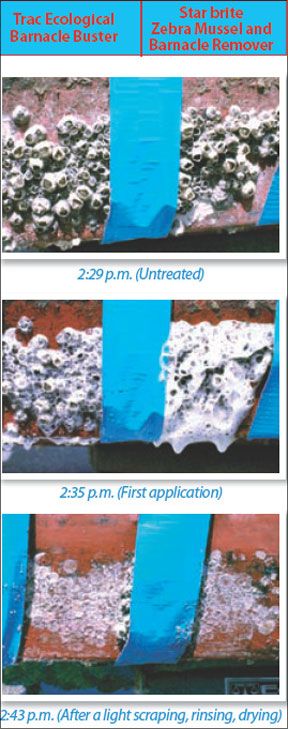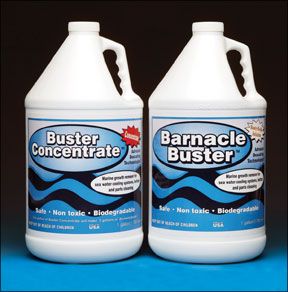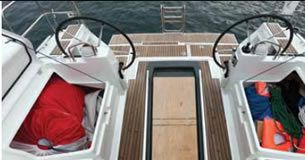Barnacle removal is ranks among the least favorite boat maintenance chore for a cruising sailor. In our last barnacle remover test, https://www.practical-sailor.com/boat-maintenance/barnacle-removers **** Youd think that people who spend so much time testing bottom paint wouldnt have a barnacle problem, but we do … a big one. Our home waters of Sarasota, Fla., are paradise for barnacles. After 18 months (seven of them in Rhode Island), the Interlux Micron Extra on the hull of one of our test boats, a 21-foot Parker powerboat, finally surrendered to the little buggers along the waterline. In our last barnacle-remover test (May 1, 2004), two products stood out. The most effective was Star brite Zebra Mussel and Barnacle Remover. The Star brites active ingredient is hydrochloric acid, an acid that produces a sharp, acrid odor, and can irritate the respiratory system. We also recommended Marsolve, which uses a less potent aqueous organic salt (hydrogen chloride) mix. Marsolve was more pleasant to work with, but not quite as effective. 166 This time we tried a solution with the promising name of Barnacle Buster from Trac Ecological, a company that specializes in making environmentally friendly cleaners and descalers for marine plumbing and engine-cooling systems. (One of their newest products is designed for cleaning head plumbing.) Barnacle Busters active ingredient is phosphoric acid, a common cleaning acid. (Several products in our May 2006 rust-stain remover test used phosphoric acid.) It comes in the ready-to-use, diluted Barnacle Buster ($23 per gallon), which has about 20 percent active ingredient, and the Buster Concentrate ($69 per gallon), which has about 85 percent active ingredient. Like the Marsolve, Barnacle Busters primary purpose is to remove scale and marine growth from cooling passages. Both are biodegradable and can be harmlessly flushed The adjacent photos document our comparison between Barnacle Buster and Star brite. (With the former, we used a 4:1 ratio of water to concentrate). The foamy Star brite was quicker to break down the shells. Although the Barnacle Buster didnt attack the adhesive as wed been told it would, it also did the job, it just took a little longer. For both, we used a plastic putty knife to lightly release the shells after application. Neither completely removed all traces of the barnacles tenacious ring bases until after a second application. We have not yet tested Barnacle Busters descaling ability, but trusted sources tell us they have had good experience with it cleaning air-conditioning and refrigeration plumbing. (The company sells a portable flushing device for this purpose.) Trac Ecological warns users that Barnacle Buster will dissolve zincs, so if you are cleaning a heat exchanger or raw water cooling system, replace your good zincs with some bad ones before flushing the system. And protect a galvanized trailer, if 288 you are working over it. Bottom line:
two products stood out. The most effective was Star brite Zebra Mussel and Barnacle Remover, but we also had good results from a milder product called Marsolve. This time around, we tried a solution with the promising name of Barnacle Buster and documented the results with time-lapse photography.
directly into the water at any dilution, the manufacturers claim. Both products are relatively mild acids, although gloves and eye protection are still recommended.
Barnacle Remover Test
Practical Sailor pits Trac Ecologicals Barnacle Buster against Star brite Zebra Mussel and Barnacle Remover.
Also With This Article...








































